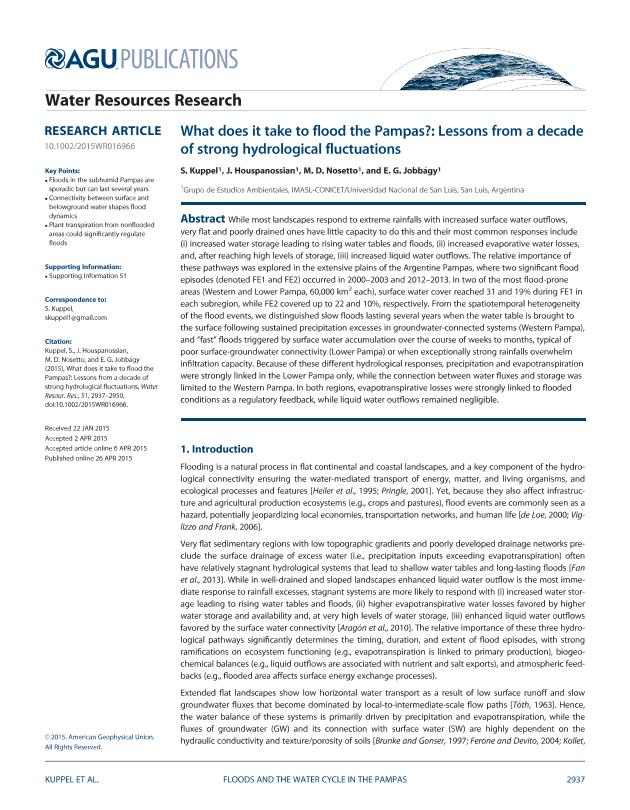Mostrar el registro sencillo del ítem
dc.contributor.author
Kuppel, Sylvain

dc.contributor.author
Houspanossian, Javier

dc.contributor.author
Nosetto, Marcelo Daniel

dc.contributor.author
Jobbagy Gampel, Esteban Gabriel

dc.date.available
2017-03-31T18:59:29Z
dc.date.issued
2015-03
dc.identifier.citation
Kuppel, Sylvain; Houspanossian, Javier; Nosetto, Marcelo Daniel; Jobbagy Gampel, Esteban Gabriel; What does it take to flood the Pampas?: Lessons from a decade of strong hydrological fluctuations; American Geophysical Union; Water Resources Research; 51; 4; 3-2015; 2937-2950
dc.identifier.issn
0043-1397
dc.identifier.uri
http://hdl.handle.net/11336/14621
dc.description.abstract
While most landscapes respond to extreme rainfalls with increased surface water outflows, very flat and poorly drained ones have little capacity to do this and their most common responses include (i) increased water storage leading to rising water tables and floods, (ii) increased evaporative water losses, and, after reaching high levels of storage, (iii) increased liquid water outflows. The relative importance of these pathways was explored in the extensive plains of the Argentine Pampas, where two significant flood episodes (denoted FE1 and FE2) occurred in 2000?2003 and 2012?2013. In two of the most flood-prone areas (Western and Lower Pampa, 60,000 km2 each), surface water cover reached 31 and 19% during FE1 in each subregion, while FE2 covered up to 22 and 10%, respectively. From the spatiotemporal heterogeneity of the flood events, we distinguished slow floods lasting several years when the water table is brought to the surface following sustained precipitation excesses in groundwater-connected systems (Western Pampa), and ?fast? floods triggered by surface water accumulation over the course of weeks to months, typical of poor surface-groundwater connectivity (Lower Pampa) or when exceptionally strong rainfalls overwhelm infiltration capacity. Because of these different hydrological responses, precipitation and evapotranspiration were strongly linked in the Lower Pampa only, while the connection between water fluxes and storage was limited to the Western Pampa. In both regions, evapotranspirative losses were strongly linked to flooded conditions as a regulatory feedback, while liquid water outflows remained negligible.
dc.format
application/pdf
dc.language.iso
eng
dc.publisher
American Geophysical Union

dc.rights
info:eu-repo/semantics/openAccess
dc.rights.uri
https://creativecommons.org/licenses/by-nc-sa/2.5/ar/
dc.subject
Floods
dc.subject
Water Storage
dc.subject
Regional Water Cycle
dc.subject
Hyperplains
dc.subject
Groundwater
dc.subject.classification
Oceanografía, Hidrología, Recursos Hídricos

dc.subject.classification
Ciencias de la Tierra y relacionadas con el Medio Ambiente

dc.subject.classification
CIENCIAS NATURALES Y EXACTAS

dc.title
What does it take to flood the Pampas?: Lessons from a decade of strong hydrological fluctuations
dc.type
info:eu-repo/semantics/article
dc.type
info:ar-repo/semantics/artículo
dc.type
info:eu-repo/semantics/publishedVersion
dc.date.updated
2017-03-31T18:13:34Z
dc.journal.volume
51
dc.journal.number
4
dc.journal.pagination
2937-2950
dc.journal.pais
Estados Unidos

dc.description.fil
Fil: Kuppel, Sylvain. Consejo Nacional de Investigaciones Científicas y Técnicas. Centro Científico Tecnológico San Luis. Instituto de Matemática Aplicada de San Luis; Argentina. Universidad Nacional de San Luis; Argentina
dc.description.fil
Fil: Houspanossian, Javier. Consejo Nacional de Investigaciones Científicas y Técnicas. Centro Científico Tecnológico San Luis. Instituto de Matemática Aplicada de San Luis; Argentina. Universidad Nacional de San Luis; Argentina
dc.description.fil
Fil: Nosetto, Marcelo Daniel. Consejo Nacional de Investigaciones Científicas y Técnicas. Centro Científico Tecnológico San Luis. Instituto de Matemática Aplicada de San Luis; Argentina. Universidad Nacional de San Luis; Argentina
dc.description.fil
Fil: Jobbagy Gampel, Esteban Gabriel. Consejo Nacional de Investigaciones Científicas y Técnicas. Centro Científico Tecnológico San Luis. Instituto de Matemática Aplicada de San Luis; Argentina. Universidad Nacional de San Luis; Argentina
dc.journal.title
Water Resources Research

dc.relation.alternativeid
info:eu-repo/semantics/altIdentifier/url/http://onlinelibrary.wiley.com/doi/10.1002/2015WR016966/abstract
dc.relation.alternativeid
info:eu-repo/semantics/altIdentifier/doi/http://dx.doi.org/10.1002/2015WR016966
Archivos asociados
